Special investigation: Slow-kill or no- kill?
By Morgan Dunbar
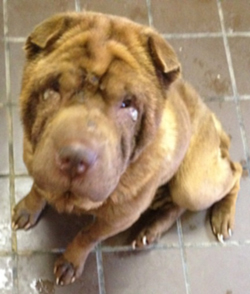 |
| "Shelby" a Shar Pei, has what appears to be a severe eye infection. As of press time he has yet to see a vet. |
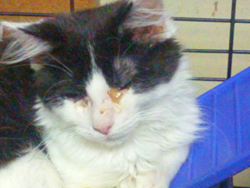 |
| Kitten with discharge caking his/her eyelids and nasal discharge. |
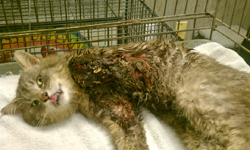 |
| Emaciated cat with severed leg bone ssticking out, covered in maggots. |
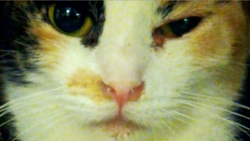 |
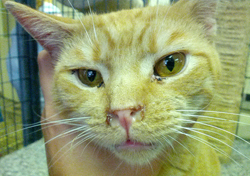 |
| Cats showing signs of respiratory infection, nasal discharge, ocular discharge, and open mouth breathing. |
 |
| Freezers hold dead animals. 8 cinder blocks piled on top keeps the overfull freezer from popping open. |
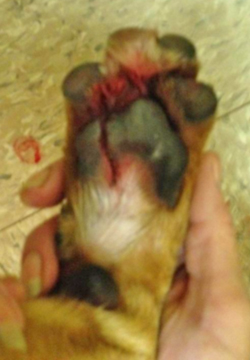 |
| "Hank"sustained a deep cut to his front paw and went without seeing a vet for 3 days. He finally received 26 stitches. |
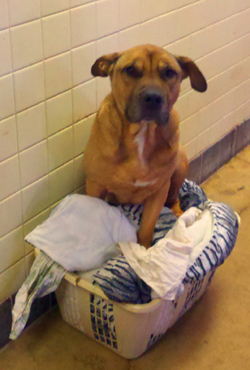 |
| "Shane" was sick for months, throwing up, and losing weight. Left to languish in the CCSPCA's "medical unit," without ever seeing a vet, Shane was found dead in his kennel. Photo courtesy of Kristi Solari. |
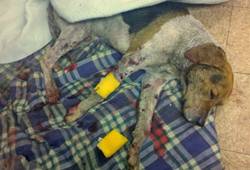 |
| "Jax" was attacked by another dog. He laid bleeding and convulsing from shock for seven hours before driven to a vet in Rochester, NY. Photo courtesy of Kristi Solari. |
While the Niagara County SPCA appears to be making strides to go No Kill, another area shelter, claiming to already be No Kill is seemingly running amok and mocking the whole concept of No Kill.
During a recent visit to the Cattaraugus County SCPA (CCSPCA) in Olean, NY., we found a shocking perversion of No Kill, one which defies imagination. After identifying the CCSPCA as a self-proclaimed No Kill facility, The Reporter decided to visit the Olean shelter to observe its operations on a normal business day.
Turning off Route 16 and into the driveway of the facility, the first thing one sees is the prominently displayed sign reading, “SPCA IN CATTARAUGUS COUNTY, A NO-KILL ANIMAL SHELTER.”
The front lobby of the facility houses approximately 30 animals, including a group of about 10 FIV positive cats, a pit bull type puppy in a dog crate, and an elderly Shar Pei dog. Before entering the main facility, there is a small room to the right, which is home to approximately 15 kittens and young cats. The kittens are housed in two rows of cages, one stacked on top of the other.
At first glance, the kittens appear healthy and socialized. Upon a little closer inspection, it is clear that one of the youngest kittens had discharge caking his/her eyelids and substantial nasal discharge. While the two other kittens in the same cage romped and played, the kitten exhibiting nasal and ocular discharge appeared lethargic, sitting at the back of the cage.
The next room is called the “Kitty Kingdom,” housing approximately 70 cats. While walking through the room, it was disturbing to see that many cats showed obvious signs of upper respiratory distress, with nasal discharge, ocular discharge, and open mouth breathing.
Exiting Kitty Kingdom, one approaches a corridor leading to a length of dog kennels. The majority of the animals in this area were literally bouncing off the walls, some circling repeatedly at high speeds and some appearing to self-mutilate, continually chewing on their paws and tails [VIDEOS AVAILABLE ONLINE]. These same behaviors were repeated in all other areas of the facility where dogs were kept.
Turning the corner from the dog kennel area was a small, windowless room, housing approximately 30 cats in 3 rows of stacked cages. The overhead lights in one half of the room were inoperable, leaving the cats in that part of the room in darkness. Barely visible in the shadows was one cat who had a severe head tilt and half closed right eye, appearing to have some kind of neurologic disorder.
Another windowless room, across the corridor, housed a group of cats in crates, many of which appeared corroded with rust. One of the cats had what appeared to be an inflamed, sunken eye socket.
During the one and a half hour tour of the facility, only one dog was observed outside of the kennels, being led through the hallway on a leash. Loaded fly strips were visible hanging from the damaged, dropped ceilings throughout the shelter.
The stench of urine and feces throughout the facility was overpowering. We observed mice scurrying down hallways and under doors. The roof, viewed from the outside of the facility, shows signs of damage and is partially covered with tarps. While leaving the facility and passing the FIV cats in the front lobby, it was noticed that one of the male cats, sitting on a cat perch, was shaking his head repeatedly and sneezing, which finally resulted in him falling sideways off the perch, landing on his side. These were not healthy or happy animals.
According to Kelly Chaffee, former CCSPCA President and current Board Member, “the facility has been No Kill since 1985.”
Chaffee’s claim that CCSPCA is a No Kill shelter is based on her belief that, if animals cannot be adopted, they should remain at the shelter indefinitely. Chaffee reports that on a given day, from 250 to 400 animals are housed onsite at the Olean facility, including cats and dogs. She explained that the facility no longer offers a low cost spay/neuter clinic, stating that the majority of animals are adopted out unneutered.
When asked who is in charge at the facility on a day-to-day basis, Kristen McDonald, current CCSPCA Board Chair, said that “all board members are in charge of the facility.” When asked how many of the Board Members are on site on a daily basis, McDonald said that no Board Members are on site on a daily basis but that a Danielle Hawley, a full-time employee, is “Lead Staff Person.”
When contacted by The Reporter, Hawley denied having any kind of “position of authority” at the shelter.
McDonald said that animals at the shelter often stay for extended periods of time, noting it is not unusual for an animal to remain in the kennels for years. McDonald also said the shelter has cooperative relationships with up to “250 different rescue groups” and that the shelter has “thousands of volunteers,” although they may “never appear at the shelter.”
When asked to confirm the numbers of rescue groups McDonald works with, a former Board Member Tina Wedge said, “That’s a blatant lie.”
Bordner and former employee Linda Vane, described multiple occasions when animals in emergency situations went without medical care for days.
Vane, whose title at the facility was “Med Tech,” stated that she had absolutely no veterinary or medical training when she started working there in March of 2012 and has no veterinary certification of any kind, despite being required to instill medications and vaccinations and tend to ailing animals.
One such animal was brought to the shelter at roughly 5:30 pm, June 13, 2012, by Cruelty Investigator Phillip Barrett. The animal had come in with a half amputated front leg, after being caught in a leg-hold trap. Barrett wrote in an email to the Board, dated June 15, 2012, that “the wound appeared to be about 3-7 days old,” based on “dead tissue.” “I didn’t observe any bleeding or maggots. As I have dealt with this type of injury and veterinarians before, I followed what they recommended in the past. I started antibiotics and kept checking on him until morning when staff came in. On my way to work… I stopped and checked on him again. There still was no bleeding or maggots.”
Linda Vane explained that when she came into work on the morning of the 14th, she noticed that contrary to what Barrett wrote, the cat was covered in maggots and was told that the cat was going to the vet. When Vane finished her rounds at about 1:00 pm, she found the cat was still lying in a crate in the lobby. At this point, Vane explains, “three employees spent 3 hours removing maggots from the cat.”
The cat was taken to a veterinarian at 4:00 pm, almost 24 hours after arriving at the facility.
According to Bordner, about a month ago, Aladdin, a black lab mix dog, had his tail bitten off by the dog in the adjacent kennel. Bordner heard the animal’s screams from the front lobby and, when he arrived at the kennel, he saw “blood everywhere,” a “piece of a tail laying on the floor,” and “bone sticking out.” Aladdin was not seen by a veterinarian for 3 days, he said.
Unlike Niagara County SPCA which, prior to this year, killed practically every animal who came through its doors, CCSPCA demonstrates a much different concept of sheltering. The CCSPCA defends its practice of confining animals in kennels for years until they are either adopted or pass away. The CCSPCA’s understanding of No Kill differs significantly from the philosophy of Nathan Winograd, originator of the No Kill movement.
Winograd said: “No Kill does not mean poor care, hostile and abusive treatment, and warehousing animals without the intentional killing. It means modernizing shelter operations so that animals are well cared for and kept moving efficiently and effectively through the shelter and into homes.”
“Animals don’t deserve to be locked up in cages forever,” said Kennel Attendant Ryan Bordner.
Tina Wedge echoes this sentiment, adding there have been “too many years of doing this. There are dogs there who aren’t walked for weeks and weeks on end. Those animals deserve a different life.”
Is it as bad as it appears?
This was just a random tour, unannounced. True we looked around and saw more than others, but we found everywhere was anything but pleasant.
It was disturbing.
We must ask, is the CCSCPA exhibiting gross negligence as a result of misguided but good intentions or is the suffering of the animals within its walls the result of the purposeful privation of care for economic gain?
See this shocking video.